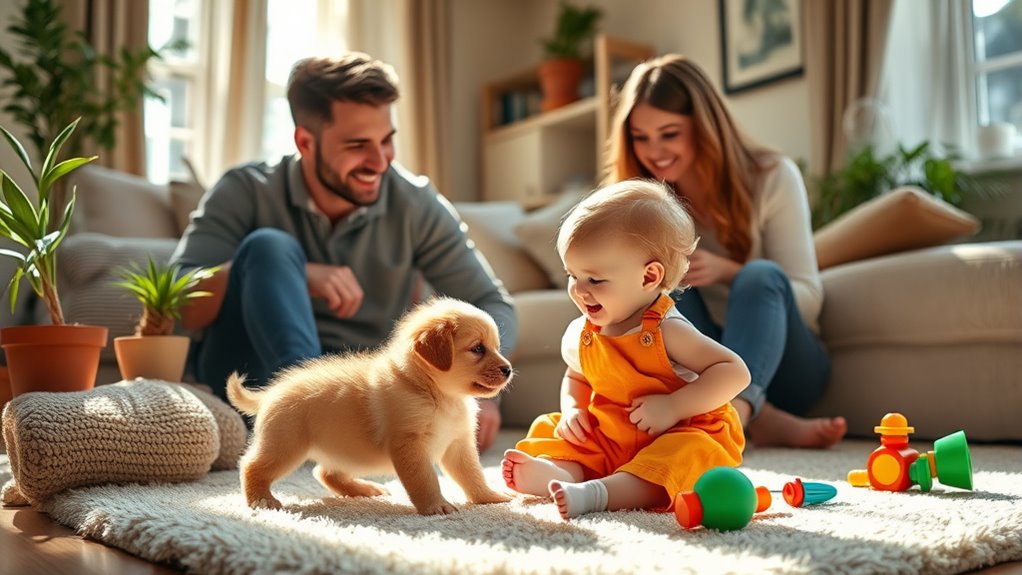When introducing a new pet to your family, establish a consistent routine with scheduled feedings, potty breaks, and playtime to provide predictability. Create a safe space for your new pet and supervise interactions with existing pets to keep everyone calm and comfortable. Use positive reinforcement and be patient as everyone adjusts at their own pace. If you want to make the progression even smoother, there are more expert tips that can help you succeed.
Key Takeaways
- Introduce pets gradually with supervised, calm interactions to build positive associations.
- Establish a consistent routine for feeding, potty breaks, and play to reduce stress.
- Create a designated safe space for the new pet to retreat and feel secure.
- Use positive reinforcement to encourage desired behaviors and foster trust.
- Observe reactions and adjust the introduction process to ensure smooth integration.

Thinking about adding a new pet to your family can be exciting yet challenging. You’re eager to welcome a furry friend into your home, but you also know that making the transition smooth is key. One of the first steps is to set clear training tips that help your new pet settle in comfortably. Consistency is crucial, so establish a routine that your pet can rely on. This might include designated feeding times, regular play sessions, and consistent commands. Training tips like positive reinforcement, patience, and gentle correction will help your new pet understand expectations and build trust with you. Remember, every pet learns at its own pace, so avoid rushing the process. With steady guidance, your new companion will soon be following the household rules and feeling secure.
Alongside implementing training tips, you’ll need to focus on adjusting routines within your household. Dogs, cats, or other pets thrive on predictability, so gradually modifying your daily schedule to incorporate the new pet’s needs will ease the transition. For example, if you’re bringing home a puppy, start with scheduled potty breaks and meal times from day one. If you have other pets, introduce them to the new arrival slowly and under controlled circumstances, ensuring everyone feels safe. Adjusting routines doesn’t mean overhauling your entire day but rather making small, consistent changes that accommodate your new pet’s requirements. This helps reduce stress and prevents confusion or territorial behaviors. As you adapt your routines, pay close attention to your existing pets’ reactions and give them time to adjust at their own pace.
It’s also important to create a welcoming environment that encourages your new pet to explore and feel secure. Set up a designated space with their bed, toys, and water, so they have a safe haven to retreat to when overwhelmed. During the initial days, supervise interactions between your new pet and existing pets, and keep introductions calm and positive. Remember that patience is essential; every animal adapts differently, and some may need more time than others. By sticking to consistent training tips and gradually adjusting routines, you’ll help your new pet feel more at home, fostering a harmonious household. Over time, the effort you put into these initial steps will pay off, resulting in a loving, well-adjusted addition to your family.
Frequently Asked Questions
How Long Should I Quarantine a New Pet Before Introducing It to Others?
You should quarantine your new pet for at least 10 to 14 days, allowing time for proper health screening. During this quarantine duration, monitor for any signs of illness and keep your new pet separate from others. This period helps prevent the spread of diseases and guarantees your new pet is healthy before introducing it to existing pets. Always consult a veterinarian for personalized advice based on your pet’s specific needs.
What Are Signs of Stress in a Newly Introduced Pet?
You notice pet anxiety and behavioral changes when your pet feels stressed. Watch for signs like excessive hiding, pacing, growling, or loss of appetite. You might see increased vocalization or destructive behaviors. These signals indicate your pet is overwhelmed. Recognizing these signs helps you respond swiftly, providing comfort and reassurance. Keep an eye out for these stress indicators to make certain your pet adjusts smoothly and feels safe in their new environment.
How Do I Introduce a New Pet to Young Children Safely?
You prioritize child safety by supervising all pet interaction, especially with young children. Teach your kids gentle handling and respect for the pet’s boundaries. Keep initial introductions brief and calm, allowing the pet to approach at their own pace. Always stay nearby to intervene if needed, and reinforce positive behavior with praise. This approach helps your child and pet build a trusting bond while ensuring safety and comfort for everyone involved.
What Are Common Health Issues to Watch for in New Pets?
Ever wonder what health issues could surprise you with a new pet? Watch for behavioral signs like lethargy, loss of appetite, or unusual hiding, which can signal illness. Keep up with their vaccination schedule to prevent common diseases. Regular vet visits are essential, and staying alert to any changes helps catch issues early, ensuring your pet stays happy and healthy. Don’t ignore small signs—they can indicate bigger problems.
Should I Feed the New Pet the Same Diet as My Existing Pets?
You should consider pet dietary compatibility and nutritional differences before feeding your new pet the same diet as your existing pets. Every animal has unique needs, so check with your vet to guarantee the diet suits your new pet’s age, breed, and health. Mixing diets without guidance can lead to nutritional imbalances or health issues. Tailor their food to meet their specific requirements for ideal health and well-being.
Conclusion
Bringing a new pet home is like planting a seed of joy that grows with patience and love. Remember, it takes time for everyone to adjust, so be patient and gentle. Celebrate small victories, and don’t rush the process. With your dedication, your new furry family member will soon feel safe and loved, just like a sunbeam crossing a cloudy sky—brightening your life in ways you never imagined.









